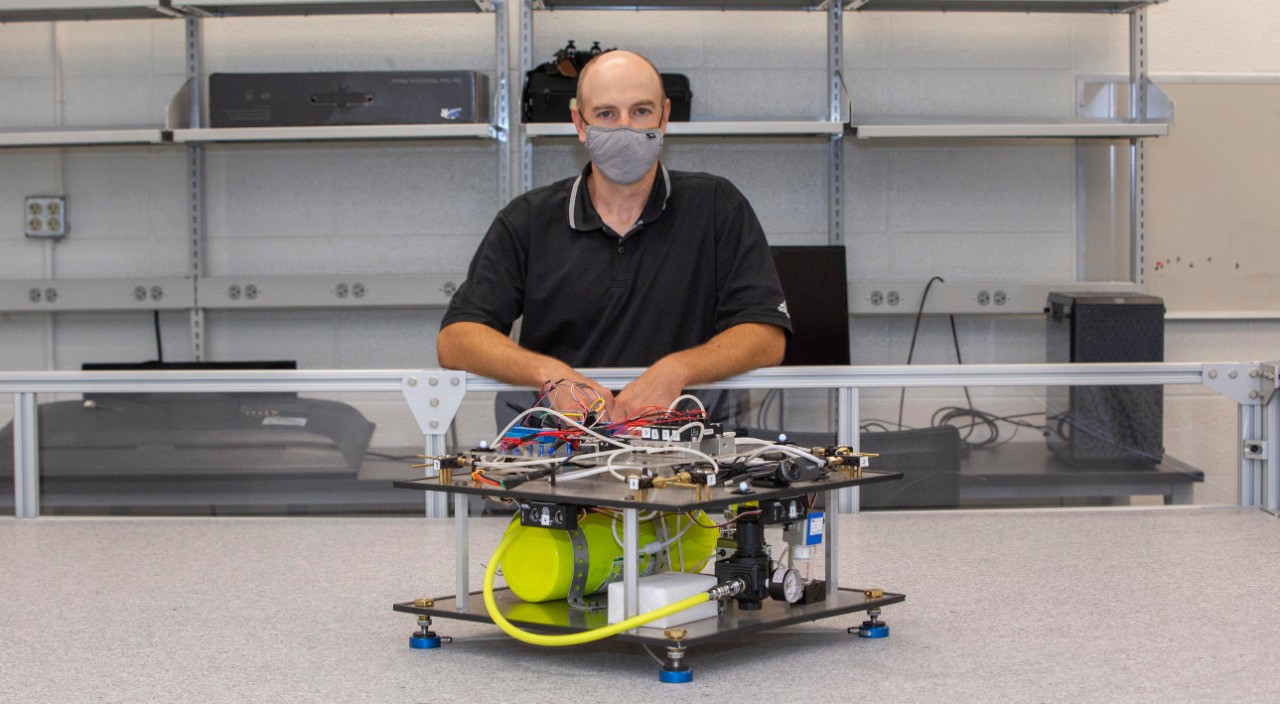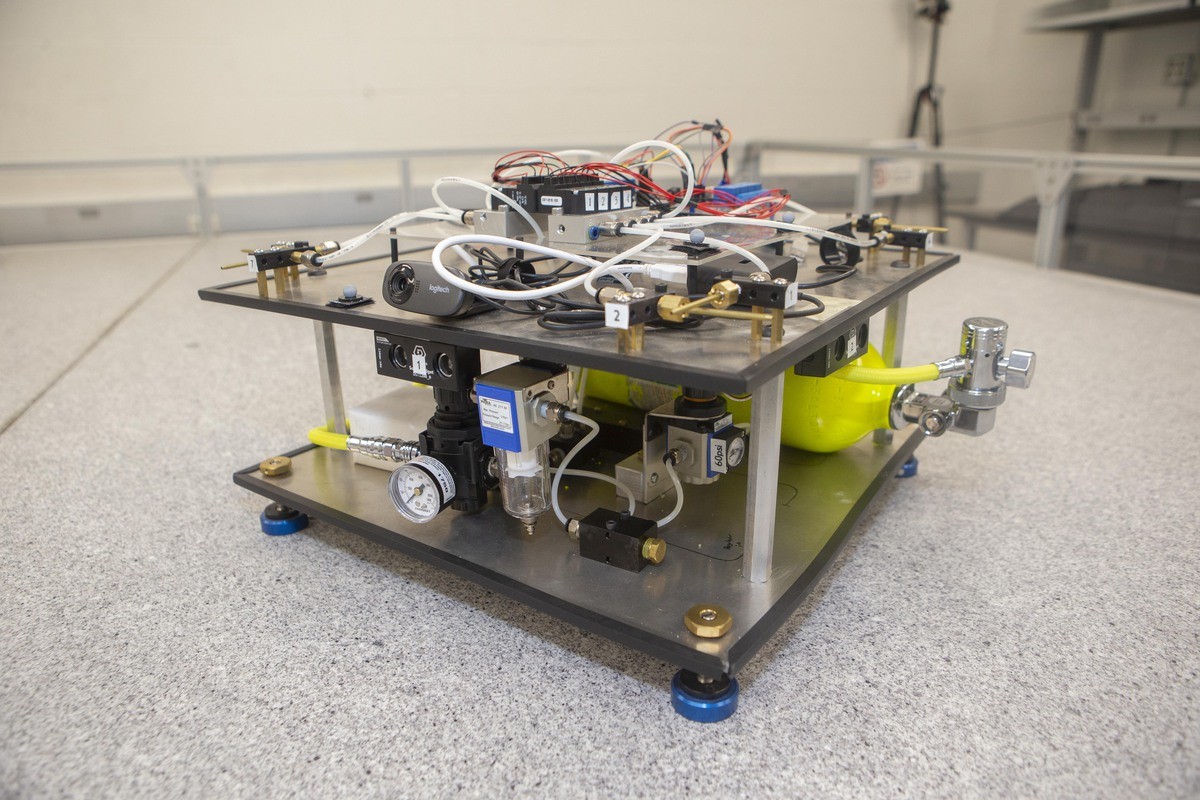
UC students design custom satellites
CubeSats put big tech in a tiny package
When you want to solve a big problem, sometimes perspective makes all the difference.
Engineering students at the University of Cincinnati are building tiny custom satellites to help scientists study some of the Earth’s most pressing environmental problems from space.
Andy Barth, an aerospace engineering student, is designing a 10-centimeter-cubed satellite, called a CubeSat, that will be deployed from the International Space Station to track the temperature of the sea surface in the Amazon River delta.
CubeSats are inexpensive, simple and reliable compared to bigger commercial satellites. Each is customized to perform a specific task. They are launched into a low, decaying orbit that gives them a narrow operating window before they eventually incinerate in the atmosphere. This keeps them from becoming dangerous flotsam to other passing satellites or launching spacecraft.
Barth is working on his project with an Ohio company called Sierra Lobo, Inc.
“This is more of a technology demonstrator to try out different sensors,” Barth said. “Their hope is to fund a bunch of these CubeSats to collect data from orbit.”
The student projects demonstrate UC's commitment to research as part of its strategic direction called Next Lives Here.

UC aerospace engineering professor Ou Ma, photographed here in his lab before the global pandemic, is helping his students design custom satellites. Photo/Andrew Higley/UC Creative + Brand
Overseeing the project is Ou Ma, a professor of aerospace engineering in UC’s College of Engineering and Applied Science. He directs UC's Intelligent Robotics and Autonomous Systems Laboratory.
Ma has spent his entire career developing new space technology. He has worked on complicated undertakings for NASA like the robotic arm for the space shuttle — projects that took teams of engineers, physicists and specialists. His name is floating 254 miles above the Earth aboard the International Space Station after he and other engineers signed their autographs on one of their completed projects.

A CubeSat. Photo/NASA
Ma said these collaborations involve lots of people who focus on perfecting one particular aspect of a massive enterprise.
“Satellites are very complicated systems. In the past we had little chance to know the whole system. Every person working on it knew just a little bit,” he said. “On the International Space Station, I worked on just one little bit. I had no idea how they designed the other systems. But with CubeSats, you know almost everything.
“The CubeSat gives us a good chance to develop the entire system.”
While there are endless varieties of satellites, they all have the same essential power, communication and navigation systems, like different breeds of a dog, he said.
“Some fundamental things are the same. You have big animals and small animals but they all have the same organs — just a different size,” Ma said. “It’s the same thing with CubeSats.”
Students in a group called the UC CubeCats are designing two satellites. One can test the radiation shielding properties of carbon fiber material. Another will take high-resolution photos of the Great Lakes from space.
It’s not an easy thing to do. It’s rocket science, after all.
Catharine McGhan, UC assistant professor, aerospace engineering

Students in UC aerospace engineering professor Ou Ma's lab design navigation and control systems to orient a satellite in space. They use a robot that hovers on a cushion of air to control it on two axes. Photo/Joseph Fuqua II/UC Creative + Brand
LEOPARDsat-1 consists of a 10-centimeter cube outfitted with sensors to record how much radiation from space seeps through different thicknesses of carbon-polyethylene samples. HABsat1 uses three cubes in a row that provide the power and internal controls to aim a camera lens in precisely the right direction to take and transmit photos of the Great Lakes in search of toxic algae blooms that could threaten wildlife and drinking water.
CubeSats represent an ideal engineering project for students to apply what they’ve learned in the classroom at UC, said Catharine McGhan, assistant professor of aerospace engineering. She is faculty adviser for the group.
“It’s not just aerospace. It’s across disciplines in engineering. We want the students to apply what they learn and have their CubeSat fly in space,” she said.

UC College of Engineering and Applied Science student Yufeng Sun works in Ou Ma's Intelligent Robotics and Autonomous Systems Laboratory. Photo/Andrew Higley/UC Creative + Brand
Designing and building a CubeSat is comparable to working on team projects the student engineers will tackle on the job. Students must make everything work in service of the mission priorities, she said.
“They are practicing the techniques they’ll be using at NASA or SpaceX or anywhere else,” McGhan said. “They have to design something within very tight constraints. And that’s how all space missions are. You start with your problem and work toward a solution.”
McGhan said students quickly learn that solving one problem can create new ones.
“It’s not an easy thing to do. It’s rocket science, after all,” she joked.
In their labs, both Ma and McGhan look for engineering solutions to Newton’s third law of motion: every action has an equal and opposite reaction.
Many satellites, including UC’s HABsat1, must be able to orient themselves in a vacuum. But that’s easier said than done.
“Astronauts trying to turn a doorknob in space will turn themselves instead if their feet aren’t planted,” McGhan said.

UC assistant professor Catharine McGhan studies topics such as space robotics, intelligent systems, risk assessment and human-robot interaction in her lab in UC's College of Engineering and Applied Science. Photo/Joseph Fuqua II/UC Creative + Brand
UC’s HABsat1 relies on a clever internal flywheel system that puts Newton’s laws into practice. Motor-driven spinning flywheels can orient a satellite on three axes. That’s how NASA aims the Hubble Space Telescope.
In his lab, Ma tests new navigation and control systems on what looks like an air-hockey table that elevates a robot on a cushion of air. This mimics the frictionless vacuum of space, at least on two axes.
“Testing a satellite is always a challenge. To duplicate the conditions of space on the ground is not easy,” Ma said. “We have this flat plane that can test the attitude and control capability of the satellite.”
UC graduate Alex Walker co-oped for Sierra Lobo, which deployed one of his satellites in February.
“It’s a cryogenic fluid experiment. It has a pressurized xenon tank. A sun shield points to deep space to cool the tank to cryogenic pressures and liquify the xenon on orbit,” he said.
Now Walker is working on a second satellite project aimed at measuring the polarity of reflected light off clouds to determine their ice density. He hopes it can be used to predict snowfall to improve weather forecasts.
UC’s College of Engineering and Applied Science is developing the latest innovations in autonomous navigation using artificial intelligence called fuzzy logic.
Ma said NASA and its contractors are risk averse, preferring proven technology even if it’s antiquated by comparison.
“The space industry is one of the most conservative for innovation. They don’t want anything new because new is not reliable. So if it fails, it’s a big loss,” Ma said. “But I’m sure NASA will embrace these new technologies.”
Featured image at top: UC student Andrew Barth stands in front of a mock satellite used to test attitude and control systems in UC's Intelligent Robotics and Autonomous Systems Laboratory. Photo/Joseph Fuqua II/UC Creative + Brand

UC student Andrew Barth, left, and UC aerospace engineering professor Ou Ma test satellite control systems on a lab table in which a robot rides a cushion of air. Photo/Joseph Fuqua II/UC Creative + Brand
Impact Lives Here
The University of Cincinnati is leading public urban universities into a new era of innovation and impact. Our faculty, staff and students are saving lives, changing outcomes and bending the future in our city's direction. Next Lives Here.
Stay up on all UC's COVID-19 stories, read more #UCtheGood content, or take a UC virtual visit and begin picturing yourself at an institution that inspires incredible stories.
Related Stories
CCM Composition Professor awarded 2025 Guggenheim Fellowship
April 22, 2025
UC College-Conservatory of Music Composition Professor Mara Helmuth is appointed to the 100th class of Guggenheim Fellows, including 198 distinguished individuals working across 53 disciplines.
UC student over the moon about NASA co-op
April 22, 2025
When he graduates from UC’s School of Information Technology in May 2025, Colin Malott will have three years of interning with NASA to put on his resume. Malott was awarded a Scholarship for Service through the government agency whose leadership says he has all of the qualities that make a model intern.
Engineering doctoral student studying cyberattack prevention...
April 21, 2025
As a top graduating student in his undergraduate class, Logan Reichling came to the University of Cincinnati to further his education through the direct-PhD program in computer science. His initial connection to UC’s College of Engineering and Applied Science was through his current advisor, Boyang Wang, in an undergraduate research program. Since arriving at CEAS, Reichling has been honored with several awards, including being named Graduate Student Engineer of the Month.
